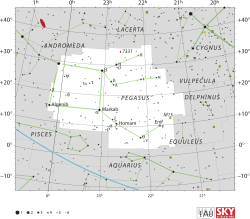Xi Pegasi
| Xi Pegasi (ξ) | |
 | |
| Observationsdata Epok: J2000.0 | |
|---|---|
| Stjärnbild | Pegasus |
| Rektascension | 22t 46m 41,58118s[1] |
| Deklination | 12° 10′ 22,3854″[1] |
| Skenbar magnitud () | +4,195[2] + 11,70[3] |
| Stjärntyp | |
| Spektraltyp | F6 V[4] + M3.5 [5] |
| U–B | -0,015[2] |
| B–V | +0,502[2] |
| Astrometri | |
| Radialhastighet () | -5,3[6] km/s |
| Egenrörelse (µ) | RA: +234,18[1] mas/år Dek.: -493,29[1] mas/år |
| Parallax () | 61,63 ± 0,19[1] |
| Avstånd | 53,2 ± 0,2 lå (16,30 ± 0,05 pc) |
| Absolut magnitud () | 3,25[7] |
| Detaljer | |
| Massa | 1,17[8] M☉ |
| Radie | 1,86[8] R☉ |
| Luminositet | 4,5[8] L☉ |
| Temperatur | 6 178 ± 26[8] K |
| Metallicitet | -0,27 ± 0,03[8] dex |
| Vinkelhastighet | 12,67[9] km/s |
| Ålder | 5,0 ± 0,5[8] miljarder år |
| Andra beteckningar | |
| 46 Pegasi, Gl 872, BD+11° 4875, HD 215648, HIP 112447, HR 8665, SAO 108165. [10] | |
Xi Pegasi (ξ Pegasi, förkortat Xi Peg, ξ Peg) som är stjärnans Bayerbeteckning, är en dubbelstjärna belägen i den södra delen av stjärnbilden Pegasus. Den har en skenbar magnitud på 4,20[2] och är synlig för blotta ögat där ljusföroreningar ej förekommer. Baserat på parallaxmätning inom Hipparcosuppdraget på ca 61,4[1] mas, beräknas den befinna sig på ett avstånd på ca 53 ljusår (ca 16 parsek) från solen.
Egenskaper
[redigera | redigera wikitext]Primärstjärnan Xi Pegasi A är en gul till vit stjärna i huvudserien av spektralklass F6 V[4]. Den har en massa som är omkring 17 procent[8] större än solens massa, en radie som är ca 1,9[8] gånger större än solens och utsänder från dess fotosfär ca 4,5[8] gånger mera energi än solen vid en effektiv temperatur på ca 6 200[8] K.
Primärstjärnan har undersökts beträffande överskott av infraröd strålning som kan indikera förekomst av en stoftskiva, men ingen sådan har upptäckts.[11] Stjärnan NLTT 54820, som har en gemensam rörelse genom rymden med Xi Pegasi A, är en röd dvärg av magnitud 11,7 och med en effektiv temperatur på ca 3 600 K[3] och en massa som är omkring en tredjedel av solens[12], belägen med en separation av 11,4 bågsekunder vid en positionsvinkel av 96,9°.[13] Detta motsvarar en projicerad fysisk separation av 192,3 AE.[11]
Referenser
[redigera | redigera wikitext]- Den här artikeln är helt eller delvis baserad på material från engelskspråkiga Wikipedia, tidigare version.
Noter
[redigera | redigera wikitext]- ^ [a b c d e f] van Leeuwen, F. (2007), "Validation of the new Hipparcos reduction", Astronomy and Astrophysics, 474 (2): 653–664, arXiv:0708.1752 , Bibcode:2007A&A...474..653V, doi:10.1051/0004-6361:20078357.
- ^ [a b c d] Kozok, J. R. (September 1985), "Photometric observations of emission B-stars in the southern Milky Way", Astronomy and Astrophysics Supplement Series, 61: 387–405, Bibcode:1985A&AS...61..387K.
- ^ [a b] Rojas-Ayala, Bárbara; et al. (April 2012), "Metallicity and Temperature Indicators in M Dwarf K-band Spectra: Testing New and Updated Calibrations with Observations of 133 Solar Neighborhood M Dwarfs", The Astrophysical Journal, 748 (2): 93, arXiv:1112.4567 , Bibcode:2012ApJ...748...93R, doi:10.1088/0004-637X/748/2/93.
- ^ [a b] Gray, R. O.; Graham, P. W.; Hoyt, S. R. (April 2001), "The Physical Basis of Luminosity Classification in the Late A-, F-, and Early G-Type Stars. II. Basic Parameters of Program Stars and the Role of Microturbulence", The Astronomical Journal, 121 (4): 2159–2172, Bibcode:2001AJ....121.2159G, doi:10.1086/319957.
- ^ Bidelman, W. P. (October 1985), "G. P. Kuiper's spectral classifications of proper-motion stars", Astrophysical Journal Supplement Series, 59: 197–227, Bibcode:1985ApJS...59..197B, doi:10.1086/191069.
- ^ Wilson, R. E. (1953), General Catalogue of Stellar Radial Velocities, Carnegie Institute of Washington D.C., Bibcode:1953GCRV..C......0W.
- ^ Huang, W.; et al. (2012), "A catalogue of Paschen-line profiles in standard stars", Astronomy & Astrophysics, 547: A62, arXiv:1210.7893 , Bibcode:2012A&A...547A..62H, doi:10.1051/0004-6361/201219804.
- ^ [a b c d e f g h i j] Ghezzi, L.; et al. (September 2010), "Stellar Parameters and Metallicities of Stars Hosting Jovian and Neptunian Mass Planets: A Possible Dependence of Planetary Mass on Metallicity", The Astrophysical Journal, 720 (2): 1290–1302, arXiv:1007.2681 , Bibcode:2010ApJ...720.1290G, doi:10.1088/0004-637X/720/2/1290.
- ^ Martínez-Arnáiz, R.; et al. (September 2010), "Chromospheric activity and rotation of FGK stars in the solar vicinity. An estimation of the radial velocity jitter", Astronomy and Astrophysics, 520: A79, arXiv:1002.4391 , Bibcode:2010A&A...520A..79M, doi:10.1051/0004-6361/200913725.
- ^ "ksi Peg". SIMBAD. Centre de données astronomiques de Strasbourg. Hämtad 2015-12-10.
- ^ [a b] Moro-Martín, A.; et al. (March 2015), "Does the Presence of Planets Affect the Frequency and Properties of Extrasolar Kuiper Belts? Results from the Herschel Debris and Dunes Surveys", The Astrophysical Journal, 801 (2): 28, arXiv:1501.03813 , Bibcode:2015ApJ...801..143M, doi:10.1088/0004-637X/801/2/143, 143.
- ^ Tokovinin, Andrei (April 2014), "From Binaries to Multiples. II. Hierarchical Multiplicity of F and G Dwarfs", The Astronomical Journal, 147 (4): 14, arXiv:1401.6827 , Bibcode:2014AJ....147...87T, doi:10.1088/0004-6256/147/4/87, 87.
- ^ Gould, Andrew; Chanamé, Julio (February 2004), "New Hipparcos-based Parallaxes for 424 Faint Stars", The Astrophysical Journal Supplement Series, 150 (2): 455–464, arXiv:astro-ph/0309001 , Bibcode:2004ApJS..150..455G, doi:10.1086/381147.




